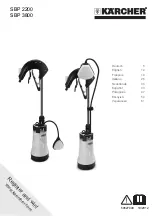
25
LEAKAGE DETECTION METHODS
The leakage detector shall be calibrated in a refrigerant-free area.
Make sure that the detector is not a potential source of ignition.
The leakage detector shall be set to the LFL (lower flammability limit).
The use of detergents containing chlorine shall be avoided for cleaning because the chlorine may react with the
refrigerant and corrode the piping.
If leakage is suspected, naked flames shall be removed.
If a leakage is found while brazing, the entire refrigerant shall be recovered from the product or isolated (e.g., Using
shut-off valves). It shall not be directly released into the environment. Oxygen-free nitrogen (OFN) shall be used
for purging the system before and during the brazing process.
The work area shall be checked with an appropriate refrigerant detector before and during work.
Ensure that the leakage detector is appropriate for use with flammable refrigerants.
LABELLING
The parts shall be labeled to ensure that they have been decommissioned and emptied of refrigerant.
The labels shall be dated.
Make sure that the labels are affixed on the system to notify it contains flammable refrigerant.
RECOVERY
When removing refrigerant from the system for servicing or decommissioning, it is recommended to remove the
entire refrigerant.
When transferring refrigerant into cylinders, make sure that only the refrigerant recovery cylinders are used.
All cylinders used for the recovered refrigerant shall be labeled.
Cylinders shall be equipped with pressure relief valves and shut-off valves in proper order.
The recovery system shall operate normally according to the specified instructions and shall be suitable for
refrigerant recovery.
In addition, the calibration scales shall operate normally.
Hoses shall be equipped with leak-free disconnect couplings.
Before starting the recovery, check for the status of the recovery system and sealing state. Consult with the
manufacturer if suspected.
The recovered refrigerant shall be returned to the supplier in the correct recovery cylinders with the Waste Transfer
Note attached.
Do not mix refrigerants in the recovery units or cylinders.
If compressors or compressor oils are to be removed, make sure that they have been evacuated to an acceptable
level to ensure that flammable refrigerant does not remain in the lubricant.
The evacuation process shall be performed before sending the compressor to the suppliers.
Only the electrical heating of the compressor body is allowed to accelerate the process.
Oil shall be drained safely from the system.
Never install motor-driven equipment to prevent ignition.
Empty recovery cylinders shall be evacuated and cooled before recovery.
INSTALING THE UNIT
The outdoor unit shall be installed in an open space that is always ventilated.
The local gas regulations shall be observed.
For installation inside a building (this applies either to indoor or outdoor units installed inside) a minimum room floor
area of space conditioned is mandatory according to IEC 60335-2-40:2018 (see the reference table in either the
indoor or outdoor unit installation manual).
To handle, purge, and dispose of the refrigerant, or break into the refrigerant circuit, the worker should have a
certificate from an industry-accredited authority.
Do not install the indoor unit if it has any drainage problems.
The indoor device must be mounted on a flat and stationary surface with a permissible load of at least 500 kstr.
Minor surface irregularities can be compensated by adjusting the feet of the device.
The ambient temperature near the heat pump indoor unit must be between 10°C and 35°C, and the relative humidity
must not exceed 80%.
Summary of Contents for Inuit 6I
Page 1: ...5 INSTALLATION MANUAL AIR TO WATER HEAT PUMP IGLU INUIT...
Page 16: ...16 IGLU Inuit 6WTI indoor unit...
Page 17: ...17 IGLU Inuit 9I outdoor unit IGLU Inuit 9I indoor unit...
Page 18: ...18 IGLU Inuit 9WTI outdoor unit IGLU Inuit 9WTI indoor unit...
Page 19: ...19 IGLU Inuit 12I IGLU Inuit 16I outdoor unit IGLU Inuit 12I IGLU Inuit indoor unit...
Page 27: ...27 SPACE REQUIREMENTS FOR OUTDOOR UNIT WHEN INSTALLING ONE OUTDOOR UNIT...
Page 43: ...43...
















































